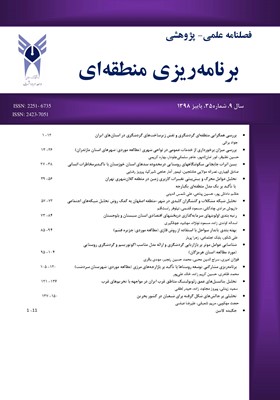تحلیل عوامل مؤثر در بکارگیری عملیات کشاورزی حفاظتی توسط بهرهبرداران کشاورز (مطاله موردی: شهرستان دیواندره)
محورهای موضوعی : فصلنامه علمی برنامه ریزی منطقه ای
مسلم سواری
1
*
![]() ,
نعمت اله شیری
2
,
حسین شعبانعلی فمی
3
,
نعمت اله شیری
2
,
حسین شعبانعلی فمی
3
1 - دانشجوی دکتری توسعه کشاورزی، دانشگاه تهران، تهران، ایران
2 - دانشجوی دکتری ترویج و آموزش کشاورزی، دانشگاه رازی کرمانشاه، کرمانشاه، ایران
3 - دانشیار گروه مدیریت و توسعه کشاورزی، دانشگاه تهران، تهران، ایران
کلید واژه: کشاورزی پایدار, کشاورزی حفاظتی, مدیریت خاک, حفاظت خاک, دیواندره,
چکیده مقاله :
هدف کلی این تحقیق، تحلیل عوامل مؤثر در بکارگیری عملیات کشاورزی حفاظتی توسط بهرهبرداران کشاورز بود. جامعه آماری تحقیق شامل 7931 نفر از کشاورزان شهرستان دیواندره است. با استفاده از نمونهگیری کوکران تعداد 126 نفر از آنها به عنوان نمونه انتخاب شدند که برای اعتبار بیشتر یافتهها تعداد 165 پرسشنامه با روش نمونهگیری تصادفی طبقهای با انتساب متناسب توزیع شد که در نهایت تعداد 150 پرسشنامه تکمیل گردید و مورد تجزیه و تحلیل قرار گرفت. ابزار اصلی تحقیق پرسشنامهای بود که روایی آن توسط پانل متخصصان و پایایی آن توسط ضریب آلفای کرونباخ تأیید شد (α>0.7). تجزیه و تحلیل دادهها بهوسیله نرمافزار SPSS win18 انجام شد. نتایج مقایسه میانگینها نشان داد که بین میزان بکارگیری عملیات کشاورزی حفاظتی توسط کشاورزان مورد مطالعه بر اساس شرکت در کلاسهای آموزشی و ترویجی ارتباط معنیداری وجود دارد. نتایج تحلیل همبستگی نشان داد که بین متغیرهای، میزان درآمد، سابقهکار زراعی، مقدار زمینهای کشاورزی، میزان سواد، میزان استفاده از رسانههای ارتباطی، میزان نگرانی از مسایل زیست محیطی، میزان انگیزه جهت شرکت در طرحهای حفاظت از محیط زیست، استفاده از نشریات آموزشی در زمینه کشاورزی، آشنایی و نگرش نسبت به کشاورزی حفاظتی با میزان بکارگیری عملیات کشاورزی حفاظتی توسط آنان رابطه مثبت و معنیداری وجود دارد. همچنین سه متغیر، میزان سواد، سایقه کار زراعی و استفاده از نشریات آموزشی و ترویجی 1/66 درصد از تغییرات واریانس متغیر وابسته بکارگیری عملیات کشاورزی حفاظتی را تبیین نمودند.
The main purpose of this study was to analysis factors affecting the practice of agriculture conservation operation by farmer exploitation. Statistical population of this study is consisted of all farmers in the Divandarreh county of Kurdistan province. By using Cochran's sampling formula, sample size was estimated as 126. Respondents were selected by using stratified random sampling method. For increasing reliability of the findings, 165 questionnaires were distributed among farmers, ultimately 150 questionnaires were completed and analyzed via SPSS software. The instrument of the study was a questionnaire which its validity was confirmed by a panel of experts and its reliability was established by calculating Chronbach's Alpha Coefficient (α>0.7). Results showed that there is a significant relationship between the use of conservation agriculture practices by farmers and extension courses of study. Results of correlation analysis showed that application of CAP by farmers significantly correlated with annual income, farmer’s work experience, farming land size , farmers' education level, using information channels, the rate of environmental problems, \motivation to participate in environmental protection projects, using education- extension journal in agriculture field, knowledge and perspective toward CAP. Also, results of the regression analysis showed that three variables consisting of farmers' education level, farm work experience and using of education-extension journal in agriculture field explained 66.1 percent of dependent variable (CAP) variances changes. At the end of this study, proposals for the adoption of conservation agriculture based on the research results is presented.
Pretty, J. (1996): Regenerating agriculture, Policies and practices for sustainability and self-reliance National Academy press, Washington, DC. Book Policies and Practice for Sustainability and Self-Reliances, Pp: 142.
4. Research on Poverty Alleviation(REPOA)

